|
RAAF Spitfire VCs
An analysis of Aeromaster's recent decal releases
compared to the actual aircraft
by Peter Malone
|
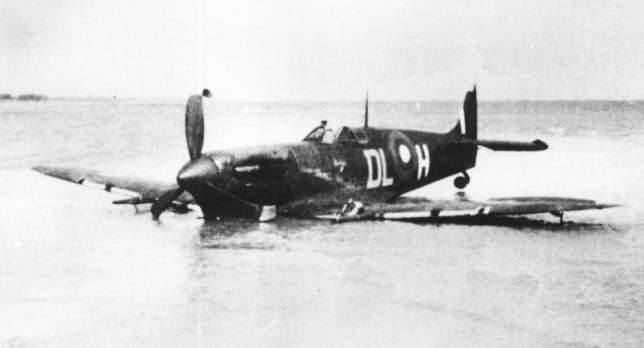
|
|
DL-H waiting to be pulled from
the drink. All three prop blades are bent indicating that the aircraft
was under power when ditched. Note that the shade of the ‘DL’ is only
marginally darker than the ‘H’. |

HyperScale is proudly supported by Squadron
To see the
Aeromaster decal sheets and their subjects,
follow this
link to Ken Bowes'
FirstLook
review elsewhere on HyperScale
On the whole these two sheets for RAAF
Spitfires are of a very high quality and reasonably accurate. Printing is very
good with excellent register and commendably thin film. However, the research
seems to have been superficial, relying only on published sources and not
referring to source material. Therefore, although they may have accurately
reproduced the illustrations in the reference material used, they have also
perpetuated the errors in that material. If you want to build a RAAF Spifire VC,
purchase these decals but, be prepared to make some changes. It is possible by
mixing and matching decals for the various aircraft to produce accurate models
of most of the aircraft depicted.
As stated above these are quite good
sheets, but it is the job of the reviewer to point out the errors. Although this
review may appear to be negative, it is not the intention of the writer to
denigrate the work done by AeroMaster, who do an excellent job producing decals
for the modeller. He just happens, after many years of research, to have access
to better information on the RAAF than that available to AeroMaster. This review
is written in the spirit of giving the modeller the best information possible.
It is up to the modeller to decide whether the suggested corrections are
worthwhile or if the author is anally retentive.
Lastly it should be noted that all
comments are based on the author’s research into RAAF camouflage and markings.
He believes them to be based on sound research methods and as accurate as he can
make them. However, no-one is infallible and they should not be taken as holy
writ.
All aircraft are illustrated with an
antenna running from the mast to the fin and an IFF antenna from fuselage to the
tailplanes. The former was not fitted to RAAF Spitfires and the IFF wires were
removed from most RAAF Spitfires. They were not on any of the Spitfires depicted
in these sheets.
Similarly all aircraft are shown with
the narrow fairings over the cannon feed chutes on the upper wing surface. In
fact, most RAAF Spitfire VCs had the standard, wider fairing which allowed for
the fitment of two cannon in each wing. Some later Spitfire VCs had the narrow
fairing and some earlier aircraft were retrofitted with it. The fairings for
each aircraft are noted in the individual comments below.
Some aircraft retained the gun heater
tube that passed through the exhausts and entered the fuselage immediately aft
of the exhausts, others had it removed leaving a hole in the panel immediately
aft of the exhausts.
The illustrations also show a padded
headrest. This is incorrect for the Spitfire VC.
All aircraft are shown with the early
style rectangular rear-view mirror. Some late model Spitfire VCs were delivered
with the circular style rear-view mirror and some had it retrofitted in service,
or removed altogether. The mirror style fitted to each aircraft is noted in the
individual comments.
It is good to see that a decal
manufacturer has recognised that the RAAF used Sky Blue codes from January 1943.
This writer would have preferred to see them a little paler, but they may ‘thin
out’ when applied to a model. They are a good match for the oft quoted FS25550,
but this, in turn, is a poor match for RAAF Sky Blue samples in the author’s
possession. These are somewhat paler, lying between FS25550 and FS25622 but,
lacking the greenness of the latter.
|
Specific Comments on Subject Aircraft |
JG795 DL-H (see title image)
On 20 June 1943, JG795 was shot up in combat with enemy
aircraft and, as it was losing coolant excessively, the pilot decided to ditch
in the sea near a beach. The aircraft as depicted on the sheet is probably based
on photos taken of it being recovered. It was subsequently repaired and returned
to active service, even after having been immersed in salt water.
The camouflage scheme for this aircraft
should be RAF Dark Earth and RAAF Foliage Green upper-surfaces over RAF Azure
Blue under-surfaces. There is no evidence that any Spitfire VC arrived in
Australia in the RAF Temperate colours of Dark Earth and Dark Green over Sky.
The over-painting of the larger roundels
is due to 54 Sqn in the second quarter of 1943 reducing the size of the RAAF
roundel on their aircraft. The change from RAF to RAAF roundel was done by No.1
Aircraft Depot and was much neater as the Depot had access to matching paint
stocks sent from the UK with the aircraft. The over-painting by 54 Sqn, (colour
unknown), is visible over the Dark Earth as well as the Foliage Green.
|
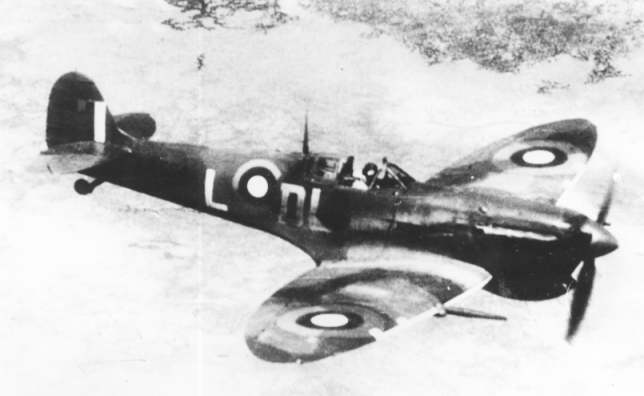
|
|
Another 54 Sqn aircraft showing
how this unit over-painted the original large RAAF roundels. |
The roundels appear to be of the correct
size. The proportions on the fuselage roundel correctly show the white as 60% of
the diameter of the blue but, on the wing roundels this proportion is
incorrectly changed to 50%. Photos of 54 Sqn aircraft at this time show the wing
roundels to have the white as 60% of the blue diameter. The fin flash is a shade
too narrow in my humble opinion. Photos show that the blue may have been an inch
or two wider than the white.
The shape and size of the codes is
excellent. The colour of the ‘DL’ on 54 Sqn machines is a matter of some
conjecture but, if it is Grey, photographs suggest that it is probably a lighter
shade than that depicted on the sheet. The letter ‘H’ is probably also repeated
under the nose, although it is not visible in photos.
My interpretation of the name on the
aircraft is ‘Buttins’. This seems to be more in keeping with the pattern of
girls’ names or nicknames on 54 Sqn aircraft. It is none too clear on the
photos, so you ‘pays your money and you makes your choice!’
Wide cannon fairings and rectangular
mirror were fitted. The white leading edge extended from the wing root to the
outboard machine gun port.
A58-252 UP-A
Firstly this aircraft is A68-252 not
-262. (There was no A58-262). UP-A was the mount of S/L Stan Galton who took
over command of the squadron in June 1944 following the unfortunate accident
which claimed the life of the previous CO, S/L Max Bott, and severely injured
the CO designate S/L Pilcher. It had a short career, being received by 79 Sqn on
7 August 1944 and was written off in a landing accident on 4 October.
|

|
|
Stan Galton’s UP-A. Note the
even-ness of the shade of the upper-surface camouflage and the light
shade of the under-surface colour on the nose and rear fuselage. |
Click the
thumbnails below to view larger images:
|
|
 |
|
Once again note the light shade of the under-surface colour. The correct shape for the ‘J’ in the name ‘JEN’ can also be seen. Note also the late style round rear-view mirror. |
|
 |
|
‘JEN’ has been ‘customised’ by the removal of the outboard cannon stubs
|
|
|
The camouflage scheme given for this
aircraft is quite reasonable as it was the standard for RAAF SpitfireVCs.
However, try as hard as he might, studying photos, this writer can find no hint
of a demarcation to show two different upper-surface colours. In fact the
upper-surface seems a remarkably uniform dark colour and the under-surface quite
light. Could this aircraft have been finished in the RAAF colours of Foliage
Green over Sky Blue? It is possible, as A58-252 would have been processed
through 1 AD at the same time as the RAAF’s first Spitfire VIIIs were being
processed and painted in the Foliage Green and Sky Blue scheme.
The roundels given are of the correct
proportions for this period, White diameter 40% of the Blue diameter. Sizes for
the fuselage and under-wing roundels are correct at 32”, but that for the
upper-wing should also be 32”, not the54” given.
The codes look to have the correct size,
shape and colour. As stated before, the serial should be A58-252 and is probably
Medium Sea Grey as depicted. The individual letter ‘A’ is repeated under the
nose in black, as depicted.
The name, ‘Jen III’, is correctly sized,
although the style of the ‘J’ is incorrect. The pilot also suggested to the
writer in an interview that the shadow shading was probably yellow.
This aircraft had a circular rear-view
mirror and narrow cannon fairings. Note that the outer stub cannon fairings have
been removed. The white leading edge extended from the wing root to the
navigation lights. Gun heater tube fitted.
A58-103 ZP-‘Delta’
This aircraft is in fact A58-103. The
serial was in black, 8” high, on the lower rear fuselage, applied parallel to
the lower-surface paint demarcation line. It was with 457 Sqn from April to
August 1944 when the unit was based at Sattler near Darwin. This aircraft had an
interesting career, flying with all the Australian Spitfire squadrons except 79
Sqn. In order, it flew with 54, 452, 457 and 85 Sqns.
This aircraft was camouflaged in RAF
Dark Earth and RAAF Foliage Green over RAF Azure Blue. See comments for DL-H
above.
|

|
|
ZP-Delta at Sattler in 1944.
The ‘A’ of the serial can be discerned just to the left of the ‘erk’
leaning on the tailplane. |
The roundels supplied are of the correct
size and proportions, although it is possible that the upper-wing roundels had
been reduced to 32’’ by this time. There is no photographic evidence to support
either possibility.
Codes are correctly rendered in Sky Blue
and the writer tends to think that the Delta symbol should also be in this
colour, although it is difficult to tell from photographs whether this or white
is correct. As stated above the serial has been omitted from the sheet.
This aircraft had the rectangular mirror
and wide cannon fairings. The white leading edge extended from the outer cannon
port to the navigation lights. Gun heater tube fitted.
A58-250 SH-K
The decals in this sheet are probably
based on a series of photos taken of this aircraft when it was involved in a
landing accident at Pearce, Western Australia on 23 May 1945.
The aircraft was finished, as depicted,
in natural metal with aluminium doped control surfaces. Spinner, front of outer
cannon subs and, aerial mast were finished in red.
|
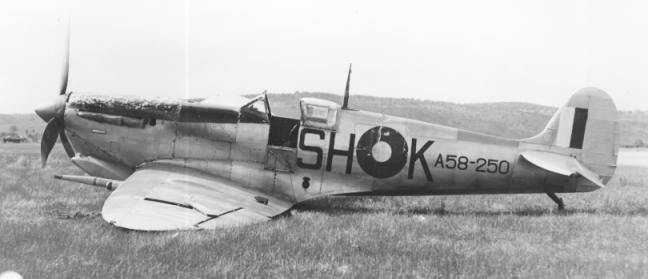
|
|
Maybe a ‘c’ should be added to
the code letters. It appears the pilot may have suffered somewhat of a
SHOCK with this landing. Note the lack of gun heating tubes
behind the exhausts and that the white seems to be missing from the
roundel. |
Click the
thumbnails below to view larger images:
|
|
 |
|
There are obvious signs of engine problems with the anti-glare paint on the cowling having blistered. The aircraft broke its back in the landing and the resultant deformed panels probably account for the damaged paint on the fuselage roundels. |
|
 |
|
The stye of the letter under the nose and the red fronts on the outer cannon stubs can be seen in this view. |
|
 |
|
And the completion of the walk round. Note the early style rectangular rear-view mirror and the narrow fairings over the cannon feed chutes |
|
|
The roundels, code letters and serials
are the correct sizes and proportions, although the writer believes that the
upper-wing roundel should be 32” rather than 36”, a relatively minor matter. See
what it looks like when on the model. The ‘K’ repeated under the nose should in
fact be white on a black square.
The name ‘Marge’ is well rendered, but
the writer believes that the scroll work depicted under it is in fact only wear
marks on the fuselage and not part of the emblem.
This aircraft had the rectangular mirror
and narrow cannon fairings. There was no white leading edge on this aircraft.
Gun heater tubes were removed.
BR543 ZP-T
This aircraft was amongst the first
received by 457 Sqn and served for a year from November 1942 to November 1943.
It flew in several combats against the enemy receiving some combat damage on 28
June. The markings given on the decal sheet would have been carried from June
onwards. Initially it carried only the individual code letter ‘T’. After moving
up to Livingstone Strip, near Darwin, 457 Sqn applied the codes ‘XB’ to many of
its aircraft in March 1943 but, no photos exist of BR543 so marked.
The colour scheme given for this
aircraft is correct and consists of RAF Dark Earth and RAAF Foliage Green over
RAF Azure Blue. The spinner and tail band were probably painted in RAAF Sky
Blue. This seems to be a marking applied to aircraft of B Flight.
|
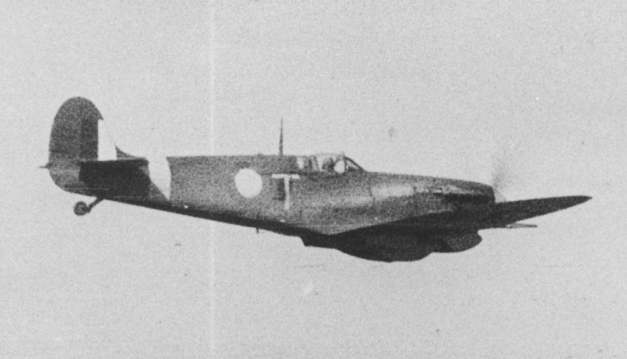
|
|
BR543 in the skies over Camden
before the squadron moved North. The Sky Blue Spinner and fuselage band
stand out. |
The roundels and codes supplied for this
aircraft are correct in both size and proportions. The diameter of the white is
correctly given as 60% of that of the blue. Only the fin flash is a little
narrow: it should be the same as that given for ZP-X and QY-G.
Unfortunately the Pegasus emblem
supplied is somewhat under-sized being only 75% the size it should be. Colour is
unknown but white seems reasonable.
|

|
|
Jack Newton with two of his
fitters. Note that the insulator and wires have been removed from the
IFF installation in the white section of the roundel. This view also
shows the size of the Pegasus emblem. |
This aircraft had the rectangular mirror
and wide cannon fairings. The white leading edge extended from the outer cannon
port to the navigation lights. Gun heater tube fitted.
BS219 ZP-X
This aircraft was also amongst the first
received by 457 Sqn. Although it was flown by F/O ‘Bush’, (not ‘Butch’),
Hamilton on a number of occasions the pilot who considered it his aircraft and
was responsible for the kill makings was F/Sgt Rex Watson. He claimed his first,
a Zero, on 15 March. He was then involved in a number of combats damaging
several aircraft and claimed his second kill, another Zero, on 10 May. His final
claim was a half share in a Dinah on 20 August. A number of photos of this
aircraft exist, from shortly after it was received by 457 Sqn at Camden, NSW,
and its early days at Livingstone Strip near Darwin, (when it only carried the
letter ‘X’ and had no victory symbols with the emblem), to a time after May when
it carried full codes and the two victory markings.
The colour scheme of RAF Dark Earth and
RAAF Foliage Green over RAF Azure Blue is correct. Once again the spinner and
tail band were probably RAAF Sky Blue.
|
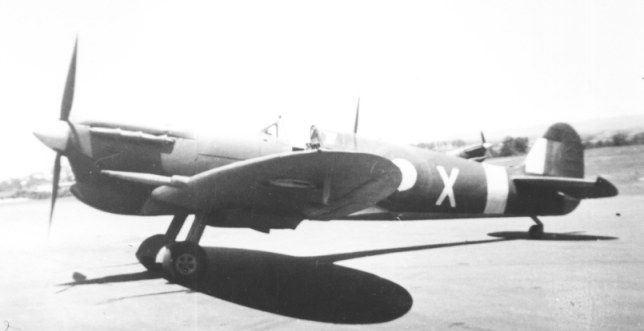
|
|
BS219 shortly after being
received by 457 Sqn at Camden. The aircraft is in pristine condition.
Note how the Sky Blue rear-fuselage band does not extend onto the
under-surface colour. |
Click the
thumbnails below to view larger images:
|
|
 |
|
Early days at Livingstone near Darwin. Jiminy has no victories to point at and the aircraft has yet to receive its 457 Squadron codes |
|
 |
|
Millingimbi Island, May 1943. Aircraft unserviceable. ‘Bush’ Hamilton has been using the aircraft’s radio to relay instructions form the ops room to his squadron mates battling Japanese aircraft overhead. Note proportions of the roundel and full codes now applied |
|
 |
|
F/Sgt Rex Watson proudly admires the emblem and victory symbols on ZP-X in mid 1943 |
|
 |
|
Not the world’s best photo but, interesting nevertheless. ‘X’ and ‘T’ are the rear two aircraft. ‘P’ and ‘Q’ carry the short lived ‘XP’ codes. The large white centres of the upper-wing roundels must have made the aircraft highly visible to the enemy |
|
|
Having produced correctly proportioned
roundels for ZP-T, for some reason unfathomable to the writer, AeroMaster have
elected to provide roundels of different proportions for ZP-X. The diameter of
the white has been increased to 66% that of the blue. The fact is that both
aircraft were processed by 1 AD within days of each other and arrived at 457 Sqn
on the same day. Both were finished with the same style of roundel. Those given
on the sheet for ZP-T are correct, those given for ZP-X are not. If you want to
model this particular aircraft use the roundels supplied for ZP-T. Once again
the codes are correct in shape and size. The only reservation the writer has is
in the shade used to represent Sky Blue. It is also likely that the individual
code ‘X’ was repeated under the nose.
The ‘Jiminy Cricket’ emblem is
commendably rendered and of the correct size. It was originally described to the
author as having yellow hands, breeches and hat band, but the grey on the decal
sheet could equally be correct.
This aircraft had the rectangular mirror
and wide cannon fairings. The white leading edge extended from the outer cannon
port to the navigation lights. Gun heater tube fitted at time of depicted
markings, but it was removed for a while at an earlier time.
A58-236 QY-G
This aircraft was operated by 452 Sqn
from Sattler Strip, near Darwin in mid 1944, not 1943 as claimed on the decal
sheet. In mid 1943 Spitfires still carried their RAF serials and, A58-236 was
not received by the squadron until April 1944. As stated on the decal
sheet, it was the aircraft usually operated by P/O ‘Junior’ Beaton, whose
nickname, and the emblem applied to the aircraft by his ground crew, was
inspired by his very youthful appearance.
Camouflage of RAF Earth Brown and RAAF
Foliage Green over RAF Azure Blue as called for on the decal sheet is correct.
However, photos in the author’s possession show the spinner to be Black, not Sky
Blue. Note also that the colour on the upper part of the air-filter fairing is
not Dark Earth but, a much lighter colour – probably a thin coat of Sky Blue
(Iain Wyllie suggests that the dark area on the tropical filter is probably
shadow and cites similarities with the photos of UP-A and ZP-Delta. This is a
perfectly logical explanation and equally as valid as my suggestion.).
|
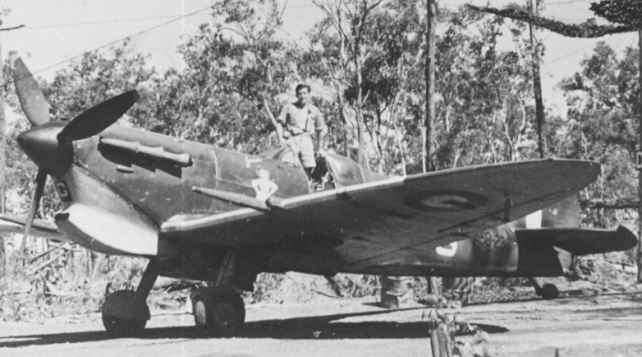
|
|
P/O Beaton posing for a shot
with QY-G. Note the black spinner, style of ‘G’ under the nose and the
over-painting evident on the upper part of the air-filter fairing |
The roundels as depicted are of the
incorrect proportions. If you want to use roundels of this size pinch those from
ZP-T. It is interesting to note that before coming to 452 Sqn this aircraft was
operated by 54 Sqn who, as we have seen earlier, were reducing the size of their
roundels by over-painting the originally applied RAAF roundels. Could QY-G have
been marked this way? The author’s photos, alas, do not show the fuselage or
upper-wing roundels. Perhaps AeroMaster has information unknown to this writer.
The style of the codes cannot be determined from the writer’s photographs but,
seems consistent with other 452 Sqn machines. Sky Blue would have been a more
likely colour than white. The serial is correctly rendered in black. The
individual letter was repeated under the nose on a black square, not just the
plain letter as supplied.
The emblem under the cockpit is well
executed and of the correct size. The facial features are rather strong and
should be reduced with some wash.
|

|
|
Junior meet Junior. Beaton’s
youthful looks, evident in this shot, were the subject of much ribbing
in the squadron. AeroMaster have reproduced this emblem well but, the
facial features need toning down to match the photo |
This aircraft had a circular rear-view
mirror and narrow cannon fairings. The white leading edge extended from the wing
root to the outboard machine gun port. Gun heater tube fitted.
Text Copyright ©
2004 by Peter Malone
Images Copyright Malone Collection
Page Created 23 August, 2004
Last Updated
24 August, 2004
Back to Reference Library
|
Home |
What's New |
Features |
Gallery |
Reviews |
Reference |
Forum |
Search